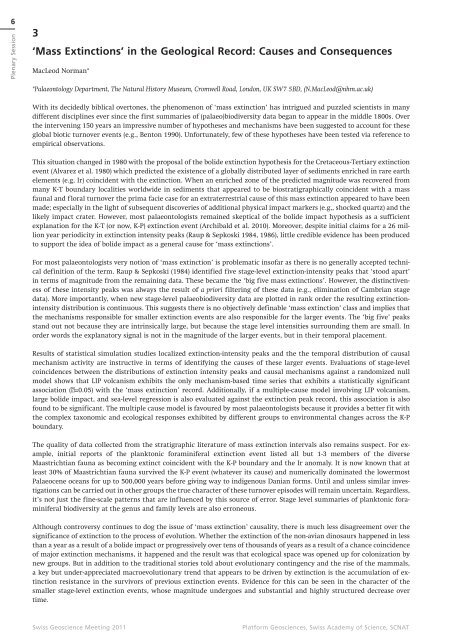2. Mineralogy – Petrology – Geochemistry - SWISS GEOSCIENCE ...
2. Mineralogy – Petrology – Geochemistry - SWISS GEOSCIENCE ...
2. Mineralogy – Petrology – Geochemistry - SWISS GEOSCIENCE ...
Create successful ePaper yourself
Turn your PDF publications into a flip-book with our unique Google optimized e-Paper software.
6<br />
Plenary Session<br />
3<br />
‘Mass Extinctions’ in the Geological Record: Causes and Consequences<br />
MacLeod Norman*<br />
*Palaeontology Department, The Natural History Museum, Cromwell Road, London, UK SW7 5BD, (N.MacLeod@nhm.ac.uk)<br />
With its decidedly biblical overtones, the phenomenon of ‘mass extinction’ has intrigued and puzzled scientists in many<br />
different disciplines ever since the first summaries of (palaeo)biodiversity data began to appear in the middle 1800s. Over<br />
the intervening 150 years an impressive number of hypotheses and mechanisms have been suggested to account for these<br />
global biotic turnover events (e.g., Benton 1990). Unfortunately, few of these hypotheses have been tested via reference to<br />
empirical observations.<br />
This situation changed in 1980 with the proposal of the bolide extinction hypothesis for the Cretaceous-Tertiary extinction<br />
event (Alvarez et al. 1980) which predicted the existence of a globally distributed layer of sediments enriched in rare earth<br />
elements (e.g, Ir) coincident with the extinction. When an enriched zone of the predicted magnitude was recovered from<br />
many K-T boundary localities worldwide in sediments that appeared to be biostratigraphically coincident with a mass<br />
faunal and floral turnover the prima facie case for an extraterrestrial cause of this mass extinction appeared to have been<br />
made; especially in the light of subsequent discoveries of additional physical impact markers (e.g,, shocked quartz) and the<br />
likely impact crater. However, most palaeontologists remained skeptical of the bolide impact hypothesis as a sufficient<br />
explanation for the K-T (or now, K-P) extinction event (Archibald et al. 2010). Moreover, despite initial claims for a 26 million<br />
year periodicity in extinction intensity peaks (Raup & Sepkoski 1984, 1986), little credible evidence has been produced<br />
to support the idea of bolide impact as a general cause for ‘mass extinctions’.<br />
For most palaeontologists very notion of ‘mass extinction’ is problematic insofar as there is no generally accepted technical<br />
definition of the term. Raup & Sepkoski (1984) identified five stage-level extinction-intensity peaks that ‘stood apart’<br />
in terms of magnitude from the remaining data. These became the ‘big five mass extinctions’. However, the distinctiveness<br />
of these intensity peaks was always the result of a priori filtering of these data (e.g., elimination of Cambrian stage<br />
data). More importantly, when new stage-level palaeobiodiversity data are plotted in rank order the resulting extinctionintensity<br />
distribution is continuous. This suggests there is no objectively definable ‘mass extinction’ class and implies that<br />
the mechanisms responsible for smaller extinction events are also responsible for the larger events. The ‘big five’ peaks<br />
stand out not because they are intrinsically large, but because the stage level intensities surrounding them are small. In<br />
order words the explanatory signal is not in the magnitude of the larger events, but in their temporal placement.<br />
Results of statistical simulation studies localized extinction-intensity peaks and the the temporal distribution of causal<br />
mechanism activity are instructive in terms of identifying the causes of these larger events. Evaluations of stage-level<br />
coincidences between the distributions of extinction intensity peaks and causal mechanisms against a randomized null<br />
model shows that LIP volcanism exhibits the only mechanism-based time series that exhibits a statistically significant<br />
association (α=0.05) with the ‘mass extinction’ record. Additionally, if a multiple-cause model involving LIP volcanism,<br />
large bolide impact, and sea-level regression is also evaluated against the extinction peak record, this association is also<br />
found to be significant. The multiple cause model is favoured by most palaeontologists because it provides a better fit with<br />
the complex taxonomic and ecological responses exhibited by different groups to environmental changes across the K-P<br />
boundary.<br />
The quality of data collected from the stratigraphic literature of mass extinction intervals also remains suspect. For example,<br />
initial reports of the planktonic foraminiferal extinction event listed all but 1-3 members of the diverse<br />
Maastrichtian fauna as becoming extinct coincident with the K-P boundary and the Ir anomaly. It is now known that at<br />
least 30% of Maastrichtian fauna survived the K-P event (whatever its cause) and numerically dominated the lowermost<br />
Palaeocene oceans for up to 500,000 years before giving way to indigenous Danian forms. Until and unless similar investigations<br />
can be carried out in other groups the true character of these turnover episodes will remain uncertain. Regardless,<br />
it’s not just the fine-scale patterns that are influenced by this source of error. Stage level summaries of planktonic foraminiferal<br />
biodiversity at the genus and family levels are also erroneous.<br />
Although controversy continues to dog the issue of ‘mass extinction’ causality, there is much less disagreement over the<br />
significance of extinction to the process of evolution. Whether the extinction of the non-avian dinosaurs happened in less<br />
than a year as a result of a bolide impact or progressively over tens of thousands of years as a result of a chance coincidence<br />
of major extinction mechanisms, it happened and the result was that ecological space was opened up for colonization by<br />
new groups. But in addition to the traditional stories told about evolutionary contingency and the rise of the mammals,<br />
a key but under-appreciated macroevolutionary trend that appears to be driven by extinction is the accumulation of extinction<br />
resistance in the survivors of previous extinction events. Evidence for this can be seen in the character of the<br />
smaller stage-level extinction events, whose magnitude undergoes and substantial and highly structured decrease over<br />
time.<br />
Swiss Geoscience Meeting 2011<br />
Platform Geosciences, Swiss Academy of Science, SCNAT









